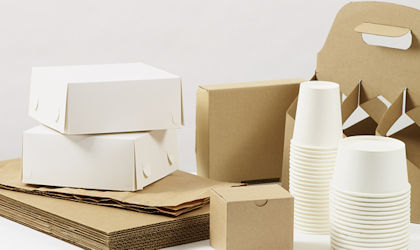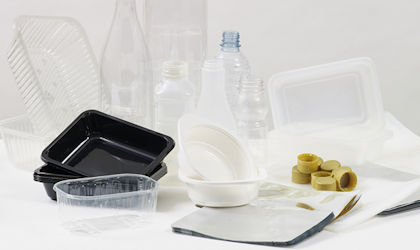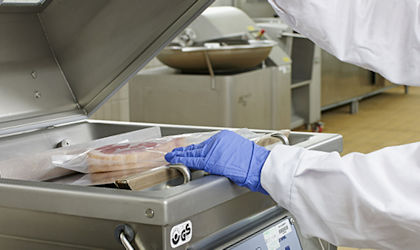Food package strength and integrity
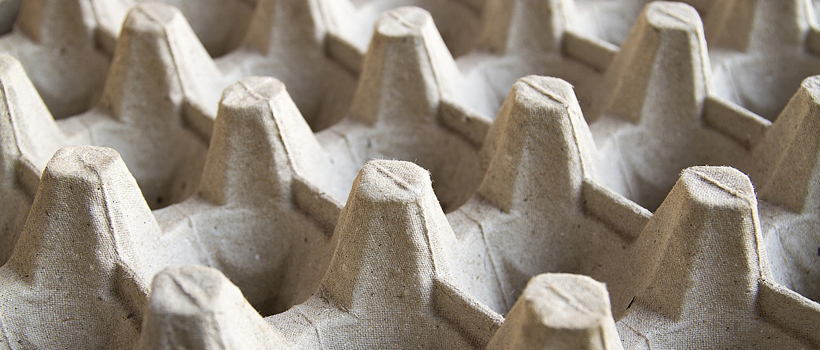
To discuss your needs
Adhesive bond strength testing
Delamination of flexible laminated packaging materials is a common cause of pack failure and print quality issues. Adhesive bond strength testing analyses the adhesive forces required to separate the laminated layers of flexible packaging materials.
Biotest
Biotesting is a form of comparative container integrity testing used particularly during the development and introduction of new or modified forms of containers.
Containers are filled with a microbiological nutrient material and heat processed. The containers are then brought into contact with contaminated cooling water with a known microorganism. Samples are stored and checked for spoilage.
Campden BRI has facilities for packing the containers, processing, storage and microbiological testing.
Burst test
The burst strength of a flexible pack is a measure of its seal strength and determined by inflating the package with air at a specified rate until it bursts. The position and type (seal or material) of failure is recorded in addition to the burst pressure value. The test is used as a means of evaluating the likelihood of pack failure when exposed to pressure differentials, such as may be experienced in during retorting or air transport. By placing the package between restraining plates, the weakest area of the seals are more likely to be detected as the stresses during pressurisation are more uniformly applied along the perimeter of the pack.
Compression strength testing
The compression strength of individual primary packaging samples such as cartons, bottles and cans is performed at Campden BRI using a Zwick Z3050 materials testing machine with a 50kN load capacity. Larger transit packaging, including fibreboard cases are also routinely tested for their compression strength.
Creep testing
Creep testing is conducted in a similar way to burst testing. However, a burst test is a measure of pack/seal strength, while a creep test is a measure of seal strength and pack integrity. During a creep test the pack is inflated to a percentage of its known burst pressure and held for 30 ora nominated time 60 seconds for a pass or fail result (in the case of seal leakage). The seals can also be measured for "seal yield" - narrowing of the seals before and after testing as an indication of internal seal peeling.
Drop test
Drop tests can be conducted on packaging in various orientations and from a range of heights to determine its impact strength.
Dye penetration testing
Dye penetration testing can detect leaks in packs down to approx 10 microns and are conducted over a period of 24 hours. These tests are especially effective for testing leaks in the seal area of the pack.
Internal pressure resistance testing
Internal pressure resistance testing is vital for containers that are intended for carbonated drinks or are otherwise subjected to changes in pressure during their intended use. This mechanical test determines whether the package meets applicable specifications and is fit for the intended use. Testing is carried out using a ramp internal pressure tester. Bottles are filled with water and the pressure is automatically increased until the bottle breaks or can deforms. The burst or deformation pressure value is recorded along with the location of the failure origin if applicable.
Integrity testing
If packaging is to provide a barrier to microorganisms, or effectively contain liquids, it must remain intact throughout the food's lifetime. Amongst the tests we can perform are:
- Heat seal integrity testing - by burst testing and vacuum testing, dye penetration and peel test.
- Microscopic seam assessment - for metal cans and other materials
- Microbiological leakage testing
Peel testing
Seals are vital to many types of food packaging; however, the role of the seal will differ from one product to another. Depending on the type of package, it may need to have mechanical strength or hermetic integrity, or be easy to open. So, the amount of force required to peel a lidding material from a pack must balance the importance of seal integrity against the requirement of convenience for consumers wishing to open the packs. When designing new pack formats during product development, it is particularly important to keep food safety/integrity in mind. It is also vital to know how seal strength may alter over time or during/after distribution. At Campden BRI, as part of our package testing services, we have the equipment to measure the peel strength of a range of pack formats. The equipment is capable of running at different angles and speeds during a test cycle.
Pendulum impact testing
Pendulum impact testing is used to determine the impact resistance, strength and breakage characteristics of a range of different pack formats in order to ensure that they are fit for purpose. Impact testing can be carried out across a range of products including glass and plastic packaging and glassware. Typically, impacts are carried out at the contact point for that particular item, such as shoulder and heel for bottles or the rim of a pint glass and the testing is carried out until failure of the sample occurs. However, testing at other specific impact positions can also be undertaken.
Tear resistance
Tear resistance testing can be conducted on sheet and film materials to measure the force perpendicular to the plane of the sheet required to tear single or multiple plies through a specified distance after tear initiation. A Zwick Z050 materials testing machine is used for this test and the results are stated in mN/ply.
Tensile and T-peel testing
A tensile strength test is a mechanical test performed on packaging materials to determine the maximum load force that can be applied to a material before it ruptures or tears. In essence it is a 'pulling' test used to measure the strength of paper, board and plastics. The material will show elastic behaviour up to a certain point and then rupture. The test can be adapted to different needs - it can be used to measure the strength or elongation of a material and its tearing resistance, as well as the force required to separate a seal. T-peel testing is a mechanical strength test conducted in a similar way as tensile testing, but it is performed on a section of a packaging seal to determine the maximum load force that can be applied to the seal before it separates.
Thrust test
Thrust testing is used in the determination of seal strength of pouches by use of a Thrust Pouch Pressure Tester. The thrust test involves the application of a constant pressure for a set period, and the observation of seal integrity after the pressure is released. This gives an indication of seal strength when a constant load is being applied at a set pressure.
Torque testing
Torque testing on (bottle and jar closures) measures the amount of force required to open a jar or bottle closure and should must balance the importance of closure integrity against the requirement of convenience for consumers wishing to open the packs. A Mecmesin Tornado digital closure torque tester is used for measuring application and removal closure torques.
Underwater vacuum / bubble emission testing
Underwater vacuum / bubble emission testing can detect leaks in packs down to approx 250 microns. These tests are widely used in the food industry as quick off-line checks during production and packing.
Key services
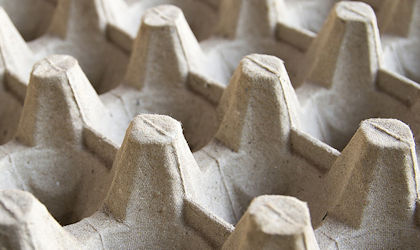
Package strength and integrity
Packaging must be able to withstand the rigours of distribution and storage.
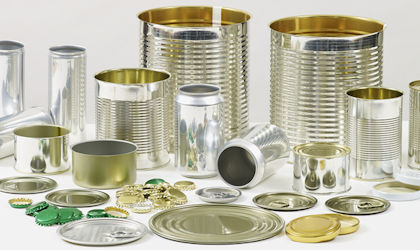
Metal
Testing of canned products within metal packaging may be required for various reasons including product/pack compatibility.
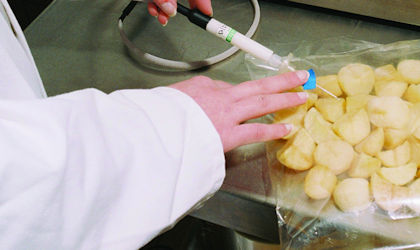
Modified atmosphere packaging
Ensuring the correct gas composition and gas:product volume ratio is critical.

Packaging down the microscope
Microscopy can use a range of techniques to examine packaging materials including plastic and metal.

Packaging migration and taint analysis
Packaging must not transfer its constituents into food to the detriment of the food's quality.
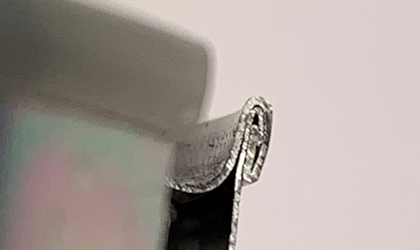
Metal can double seam assessment and troubleshooting
We can assess internal and external dimensions for any defects and breaching of critical seam parameters
Packaging training courses
Explore our packaging related courses including; Packaging technology for non-packaging technologists and MAP (modified atmosphere packaging) – an introduction
Are you getting the most from your Membership?
Watch our membership FAQ videos and find out more about Member Service Account spending, Member Interest Groups, help and advice
Where we refer to UKAS Accreditation
The Campden BRI group companies listed below are accredited in accordance with the recognised International Standard ISO17025:2017 by the United Kingdom Accreditation Service (UKAS). The accreditation demonstrates technical competence for a defined scope of methods, specific to each site, as detailed in the schedules of accreditation bearing the testing laboratory number. The schedules may be revised from time to time and reissued by UKAS. The most recent issue of the schedules are available from the UKAS website www.ukas.com. Campden BRI (Chipping Campden) Limited is a UKAS accredited testing laboratory No. 1079


